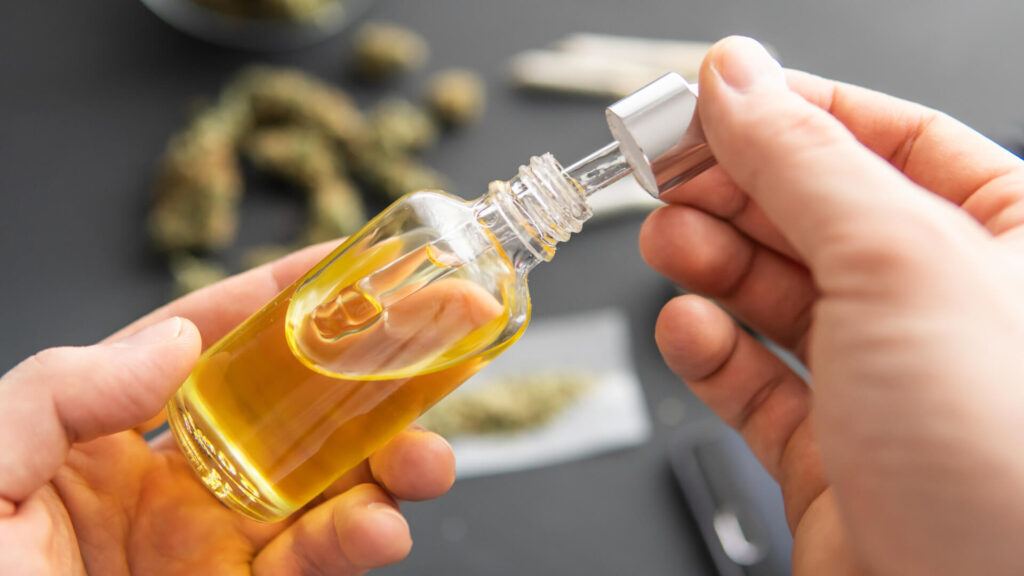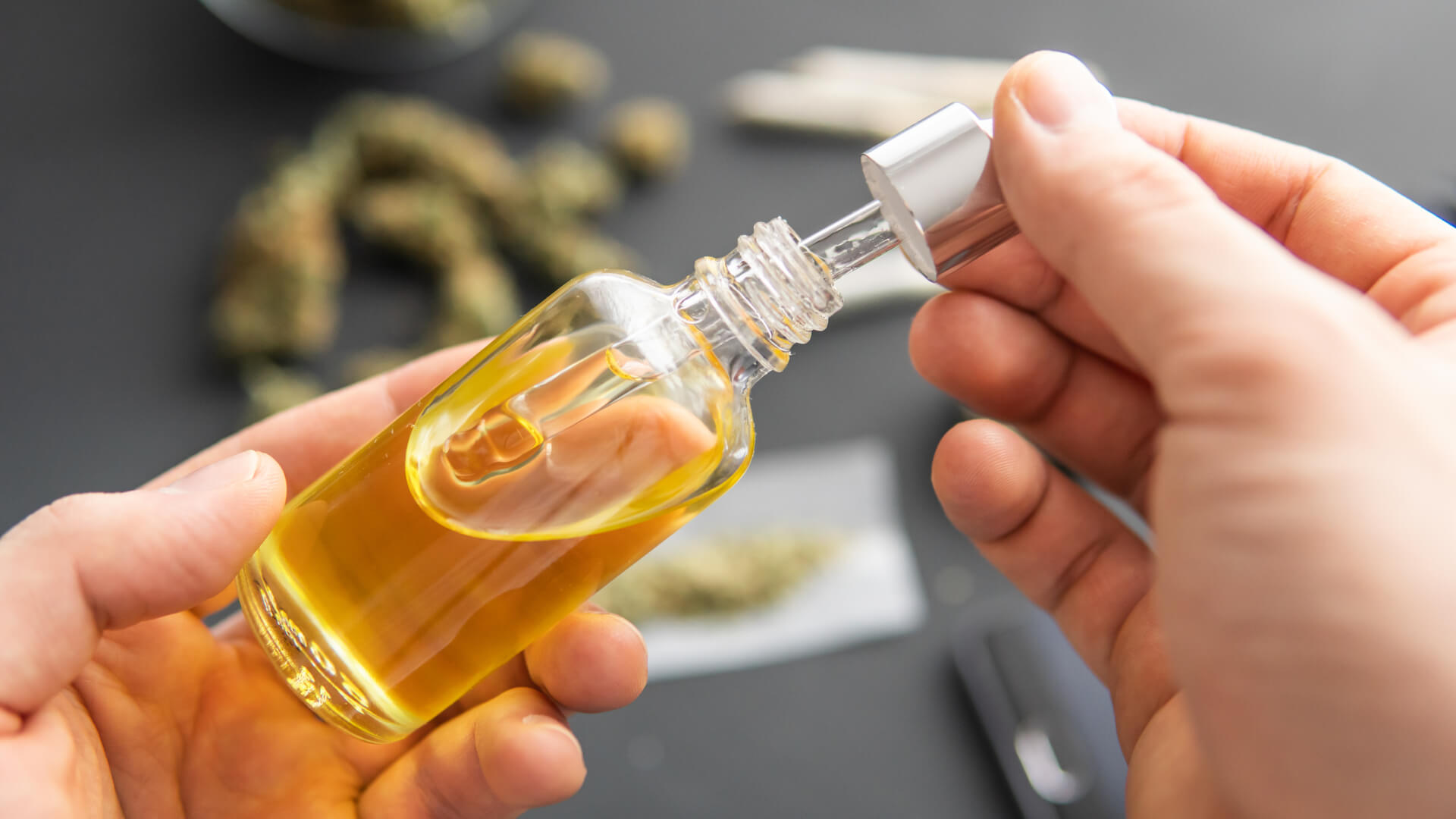Of all the cannabis products available today, liquid THC is one of the strongest and easiest to use.

These days, there are endless ways to enjoy cannabis, from classic flower to unique edibles to a wide variety of concentrates. One type of cannabis concentrate that has gained popularity in recent years is liquid THC. What is liquid THC, how is it made, and how do you use it? We’ll answer your questions in this handy guide.
What is Liquid THC?
Liquid THC, also known as “tincture” or “liquid marijuana”, is a highly potent product that results from extracting cannabinoids, mainly THC, from cannabis flowers, leaves, and other plant material.
THC is short for delta-tetrahydrocannabinol. As you may already know, THC is the main psychoactive component and one of the most abundant cannabinoids found in cannabis. Liquid THC is often bottled and sold in the form of a tincture or vape juice.
The process to create liquid THC is typically performed in a highly controlled laboratory setting by a professional extractor, but there are also methods of extracting at home. Professionally extracted liquid THC can contain a THC concentration of 90% or greater.
This is a significantly higher concentration than dry flower, whose THC concentration usually ranges between 15 and 25 percent. For this reason, liquid THC users should exercise caution when consuming, especially for the first time. Those who are sensitive to THC or who are prone to anxiety and paranoia may benefit from choosing a less concentrated cannabis product.
How to Use Liquid THC
One of the benefits of liquid THC is its wide range of possible uses. The following are three of the most common ways to use liquid THC.
Vaping
Commercially-made liquid THC is often used in conjunction with vape products. The benefit of this method is that the effects of the THC are felt nearly instantaneously, similar to a smoking dry flower, but with the added benefit of significantly less odor. This means that liquid THC can be used more discreetly. Vapes also use lower temperatures compared to smoking, which can mean less cannabinoid loss and less lung irritation.
It is important to note, however, that the long-term effects of vaping have not been adequately studied yet. As with all recreational substances, it is important to evaluate the health risks of vaping and make an informed decision.
Sublingual Method
For many users, the simplest way to consume liquid THC is to use a dropper to place it under the tongue. Commonly seen with CBD oil, the cannabinoids are absorbed through the thin membrane of the soft skin within the mouth. This method can be more effective than simply swallowing liquid THC because more cannabinoids are absorbed directly into the bloodstream, rather than passing through the acidic environment of the stomach.
Taking liquid THC under the tongue and allowing the cannabinoids to absorb for 1-2 minutes before swallowing may also help you experience the effects faster.
Edibles
Liquid THC is easy to incorporate into many edible products for a tasty medicated treat. One of the benefits of liquid THC is that cannabinoids have already been decarboxylated in the manufacturing process. When making most edibles with dry flower, the cannabis must be decarboxylated and infused with fat before incorporating into a dish such as a brownie or gummy, which can take 3 hours or more.
Liquid THC can be added directly into any recipe, saving time, effort, and cleanup. You can incorporate this cannabis concentrate into smoothies, sauces, baked dishes, and much more. Remember that cannabinoids can degrade when overheated, so opt for the lowest possible temperatures when cooking with cannabis. It’s also important to remember that edibles take significantly longer to take effect compared to vaping or taking under the tongue. Wait at least 2 hours after consuming before considering increasing your dose.
How to Make Liquid THC
While thoroughly lab-tested THC products purchased from reputable businesses are the best way to ensure you’re getting a quality product, there are also three easy methods of making your own liquidTHC—either hot, cold, or room temperature.
There are some home appliances marketed to make tincture-making as easy as possible. The Levo, for example, has a lot of credibility in the homemade tincture space.
This homemade method uses alcohol, so it is not recommended for vaping or for those under the legal drinking age. It is best taken under the tongue or added to food products.
To make your own liquid THC, you’ll need:
- Cannabis: It’s up to you to decide how much cannabis you will use to create your liquidTHC. To calculate the amount of THC in your final product, multiply the number of grams you’re using by 1000 to determine the number of milligrams, then multiply this number by the THC percentage. For example, if you use 5 grams of cannabis that has a THC concentration of 25 percent, the resulting liquid THC would contain 1250 mg THC: 5(1000)(.25)=1250
- Alcohol: Use high-proof neutral alcohol such as Everclear for best results. Do not use isopropyl(rubbing) alcohol.
- Baking sheet
- Parchment paper
- Grinder or scissors
- Mason jar
- Cheesecloth or strainer bag
- If using the hot method, you will also need a saucepan and a digital kitchen thermometer.
Step 1: Grind and Decarboxylate
No matter which method you use, you’ll begin by decarboxylating your cannabis in order to activate the THC. Preheat your oven to 240°F/115°C. Using your grinder or scissors, coarsely grind or chop your cannabis until the pieces are roughly the size of a grain of rice. Line a baking sheet with parchment paper and spread the ground cannabis out onto the paper in one even layer. Place in the oven for 30-40 minutes, stirring every 10 minutes or so to ensure even cooking. Your cannabis should look slightly toasty but not burnt.
Remove the pan from the oven and allow your cannabis to cool.
Step 2: Jar, Store, and Steep
Once cooled, place your decarboxylated cannabis into the Mason jar. Add in enough alcohol to completely cover the plant matter.
If using the room temperature method, close the lid of the jar tightly and store in a cool, dark location such as a pantry or cabinet. Allow the mixture to steep for a minimum of 14 days or up to 2 months. Shake the jar every few days to help the cannabinoids incorporate with the alcohol. When you’re ready, use a cheesecloth or strainer bag to separate the solid material from the liquid-THC and store in an airtight container.
Step 3 (Cold Method): Freeze, Shake, and Strain
If using the cold method, place your jar in the freezer for one week, remembering to give the jar a vigorous shake once per day. Once ready, strain out the plant material and store it.
Step 3 (Hot Method): Heat, Cool, and Strain
Finally, if using the hot method, place a saucepan filled with water on the stove and bring to a simmer. Add the jar to the water and use the digital thermometer to ensure that the contents of the jar do not exceed 170°F/76°C. If the mixture becomes too hot, turn down your stove’s temperature. Continue heating for approximately 30 minutes. Allow the jar to cool and strain the plant matter from the liquid THC.

